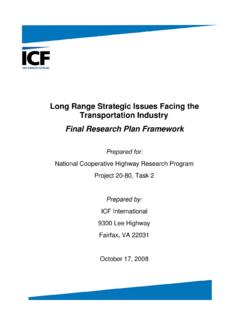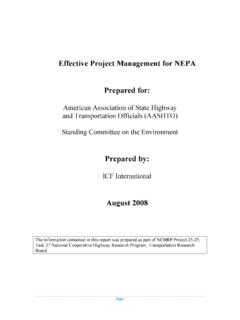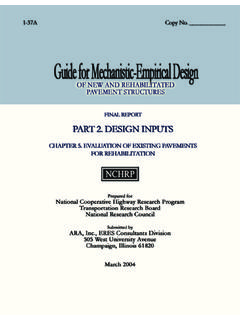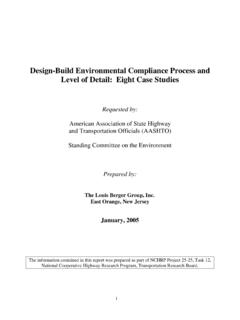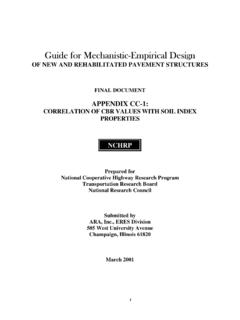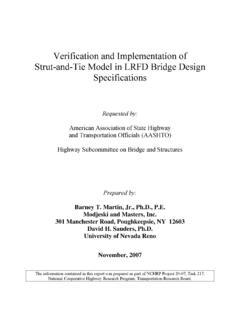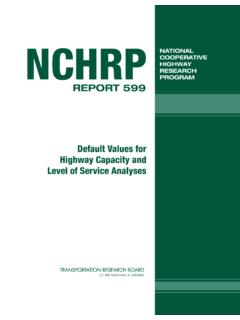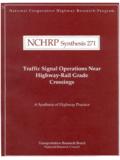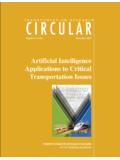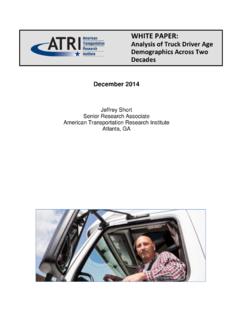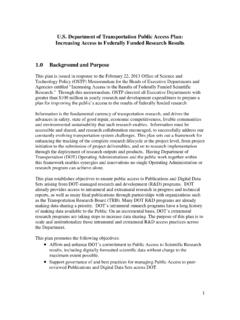Transcription of REEVALUATIONS OF NEPA DOCUMENTS
1 REEVALUATIONS OF nepa DOCUMENTS Requested by: American Association of State Highway and transportation Officials (AASHTO) Standing Committee on Environment Prepared by: ICF Consulting Fairfax, VA March 2008 The information contained in this report was prepared as part of NCHRP Project 25-25, Task 28, National Cooperative Highway research Program, transportation research Board. Acknowledgements This study was requested by the American Association of State Highway and transportation Officials (AASHTO), and conducted as part of National Cooperative Highway research Program (NCHRP) Project 25-25. The NCHRP is supported by annual voluntary contributions from the state Departments of transportation . Project 25-25 is intended to fund quick response studies on behalf of the AASHTO Standing Committee on Environment. The report was prepared by ICF International. The study Principal Investigators were Matthew Barkley and John Hansel of ICF International. The work was guided by a task group chaired by Alfredo Acoff (Alabama DOT), Jonathon Cox (Georgia DOT), Keith Hall (Connecticut DOT), John Mettille (Kentucky DOT), Steve Reed (New Mexico DOT), Andrea Stevenson (Ohio DOT), Lamar Smith ( DOT), and Danna Powell (NCHRP).
2 The project was managed by Christopher Hedges, NCHRP Senior Program Officer. Disclaimer The opinions and conclusions expressed or implied are those of the research agency that performed the research and are not necessarily those of the transportation research Board or its sponsors. This report has not been reviewed or accepted by the transportation research Board s Executive Committee or the Governing Board of the National research Council. NCHRP Project 25-25, Task 28 CONTENTS EXECUTIVE SUMMARY 1 1 INTRODUCTION 2 Overview and Purpose 2 research Methodology 3 Report Organization 4 2 reevaluation REGULATORY FRAMEWORK AND LEGAL CONSIDERATIONS 5 Summary of reevaluation Regulations, Policy, and Guidance 5 reevaluation Case Law 7 3 STATUS OF THE reevaluation PROCESS 9 Summary of State DOT Survey Responses 9 Best Practices 11 Challenges and Areas for Improvement 14 4 RECOMMENDED GUIDANCE AND PROCESSES FOR CONDUCTING REEVALUATIONS 16 Projects With Categorical Exclusion Designations 16 Projects With Completed Environmental Assessments 17 Projects With Completed Environmental Impact Statements 17 5 CONCLUSIONS 20 APPENDIX A: COURT CASE SUMMARIES 21 APPENDIX B: SURVEY QUESTIONS FOR STATE DOTS 35 APPENDIX C: SAMPLE reevaluation FORMS 36 APPENDIX D.
3 SAMPLE reevaluation OF A FINAL ENVIRONMENTAL IMPACT STATEMENT 60 REFERENCES 77 NCHRP Project 25-25, Task 28 NCHRP Project 08-36, Task 35 1 EXECUTIVE SUMMARY Since the enactment of the National Environmental Policy Act ( nepa ), federal agencies have consistently been encouraged to complete environmental impact analyses as early as possible in their project planning processes. FHWA has clearly tried to follow this mandate, but because its project development process can frequently span several years and contain multiple decision points, the initial nepa document can become outdated or stale in its ability to support subsequent decisions.
4 For example, changes can occur over time in the design of the project, the environmental requirements applicable to the project, or within the environment in which the project will be located. Consequently, FHWA and the state transportation agencies (hereafter state DOTs) who partner with FHWA in the preparation of nepa DOCUMENTS must frequently check to see if an aging nepa document remains current in light of a pending project development decisions. FHWA refers to these checks as REEVALUATIONS . Although FHWA has established a requirement to reevaluate its nepa DOCUMENTS , it has provided little guidance to its field offices or the state DOTs on how to satisfy this requirement. Accordingly, questions have arisen on how well this decentralized approach to REEVALUATIONS is working across the states. This study was designed to review current performance, identify problems as well as best practices, and provide any process recommendations, if applicable. The study found that most of the twenty-seven state DOTs that responded to the survey are not experiencing significant problems in conducting REEVALUATIONS .
5 Where problems have existed, several state DOTs worked closely with their FHWA Division Offices to develop solutions. These solutions have frequently included agreed upon forms and formats for conducting and documenting REEVALUATIONS as well as the establishment of maximum timeframes, such as one year, after which a new reevaluation would be necessary. Several examples of these best practices are provided in this study and most are readily available on state DOT websites. Consequently, any state DOT or FHWA office that continues to experience reevaluation problems can find a variety of successful approaches. Most importantly, close coordination and consultation between a state DOT and its FHWA Division Office coupled with staff training on conducting REEVALUATIONS appear to be the key ingredients to effectively streamlining and completing the reevaluation process. One very important reason for getting REEVALUATIONS right, especially written REEVALUATIONS , is that they can save FHWA and state DOTs time and money, as demonstrated by recent federal court decisions.
6 The courts continue to view revaluations for environmental impact statements (EIS) as an effective tool for determining and documenting why an existing nepa document remains valid and does not need to undergo potentially costly and time consuming supplementation. The federal courts, however, have also been clear in reminding federal agencies that REEVALUATIONS are not nepa DOCUMENTS , but rather decision DOCUMENTS on whether or not an EIS requires supplementation. Consequently, an agency can neither use a reevaluation in an attempt to remedy any gaps in the impact analysis that should have been addressed in the original nepa document , nor offer to do a reevaluation as a defense to postponing a challenge to a completed nepa document , such as a final EIS. NCHRP Project 08-36, Task 35 21 INTRODUCTION Overview and Purpose A reevaluation is an analysis of the changes in a project or existing environment at specified times in the Project Development Process (PDP).
7 1 The PDP includes multiple decision points such as final design, right-of-way acquisition, and bid letting. Each of these decision points requires the state DOTs and FHWA to reevaluate the nepa document , nepa decision, and potentially any related environmental studies. REEVALUATIONS need to be performed when and anytime there has been little activity on a project or prior to requesting FHWA to take an REEVALUATIONS can serve as an efficient and effective means for evaluating design changes or addressing circumstances that develop after a nepa decision is rendered. However, if the requirements and intent of the reevaluation process are not properly understood and managed, REEVALUATIONS also can create challenges for state DOTs as they strive to deliver projects on budget and on schedule. In an effort to prevent delays, many state DOTs initiate the nepa process and corresponding environmental studies as early as possible during the planning stage of project development. The nepa process, environmental studies, and an initial design are often completed long before the project will go to construction.
8 As time passes, changes in land use, threatened and endangered species, historic properties, environmental laws and regulations, and other resource areas can occur. The public s perception of environmental issues, industry standards, and methods for conducting environmental analyses can also change. A reevaluation can be an effective means for evaluating such changes and can assist state DOTs in determining if additional nepa documentation and environmental studies are required. Typically, the nepa process for a transportation project relies on conceptual level design and engineering data. Once environmental studies are complete and a nepa decision is rendered, detailed final design and engineering data are developed. Differences often occur between the conceptual design evaluated in the environmental studies and nepa process and the post- nepa process final design and engineering phase of a project. A reevaluation provides an effective means for evaluating the design changes relative to previous environmental analyses conducted pursuant to nepa .
9 Aside from design changes, other changes can lead to REEVALUATIONS of nepa DOCUMENTS and supporting studies. For example, nepa DOCUMENTS and corresponding environmental studies are required to address the full length and scope of a proposed action, which often require years to fund and During this time, changes can occur in terms of land use, project design, or even in the funding mechanism itself. For example, a project may be developed and the initial segment constructed through a traditional funding mechanism and the standard design-bid-build process. However, tolling and use of a design-build process may provide a means to accelerate construction of other segments of the project. Use of tolling can result in the need for additional analyses of impacts associated with environmental justice, light, air quality or noise depending on the specific project location and means for collecting tolls. 1 Draft: reevaluation of Environmental DOCUMENTS : FHWA Office of nepa Facilitation in conjunction with an unknown FHWA Division Office.
10 Posted on the RE: nepa website on August 5, 2002 as a reply to the reevaluation Process 23 CFR thread. 2 Lamar Smith s August 30, 2006 reply to the FONSI reevaluation thread included under nepa Process and Evaluation heading on the RE: nepa website ( ). Retrieved on October 26, 2006. 3 23 CFR (f)(1-3) NCHRP Project 08-36, Task 35 3In addition to tolling and other innovative financing options, many state DOTs are using the design-build method of project delivery to reduce project costs and to complete projects faster. The design-build project delivery method can result in substantial deviations from the design concepts analyzed in the nepa /environmental process. REEVALUATIONS provide a means for addressing these types of changes and ensuring environmental compliance. Many factors influence the level of detail and types of analyses required for a reevaluation . Likewise, different state DOTs and FHWA Divisions employ different policies, procedures, and processes for completing REEVALUATIONS .
